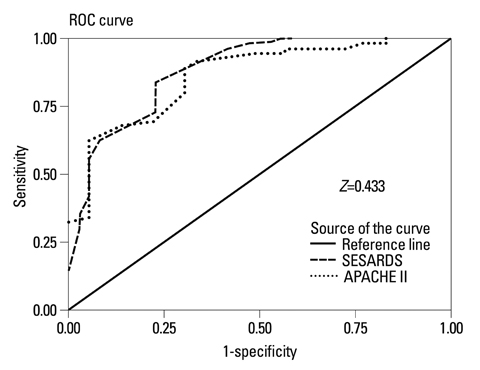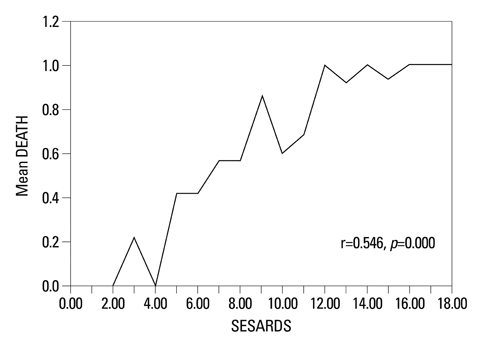Yonsei Med J.
2013 Jul;54(4):935-941. 10.3349/ymj.2013.54.4.935.
Establishment and Evaluation of a Simplified Evaluation System of Acute Respiratory Distress Syndrome
- Affiliations
-
- 1Department of Respiratory and Critical Care Medicine, Nanfang Hospital, Southern Medical University, Guangzhou, China. hxkcai@126.com
- 2Department of Health Statistics, Southern Medical University, Guangzhou, China.
- KMID: 2158229
- DOI: http://doi.org/10.3349/ymj.2013.54.4.935
Abstract
- PURPOSE
In recent years, a variety of acute respiratory distress syndrome (ARDS) evaluation systems have been developed worldwide; however, they are not so convenient for the doctors clinically, we decided to establish and evaluate a simplified evaluation system of ARDS (SESARDS).
MATERIALS AND METHODS
Data from 140 ARDS patients (derivation data set) were collected to screen for prognostic factors affecting outcomes in ARDS patients. By logistic regression analysis, scores were allocated to corresponding intervals of the variables, respectively, by means of analysis of the frequency distribution to establish a preliminary scoring system. Based on this primary scoring system, a definitive evaluation scheme was created through consultation with a panel of experts. The scores for the validation data set (92 cases) were assigned and calculated by their predictive mortality with the SESARDS and acute physiology and chronic health evaluation II (APACHE II). The performance of SESARDS was compared with that of APACHE II by means of statistical analysis.
RESULTS
The factors of age, pH, Glasgow coma scale (GCS), oxygenation index (OI), and the lobes of lung were associated with prognosis of ARDS respectively. The sensitivity and specificity of SESARDS for the validation data set were 96.43% and 58.33%, respectively. On the AUC, no significant difference between APACHE II and SESARDS was detected. There were no significant differences between the prediction and the actuality obtained by SESARDS for the validation data set the SESARDS scores were positively correlated with the actual mortality.
CONCLUSION
SESARDS was shown to be simple, accurate and effective in predicting ARDS progression.
MeSH Terms
Figure
Reference
-
1. Luhr OR, Antonsen K, Karlsson M, Aardal S, Thorsteinsson A, Frostell CG, et al. The ARF Study Group. Incidence and mortality after acute respiratory failure and acute respiratory distress syndrome in Sweden, Denmark, and Iceland. Am J Respir Crit Care Med. 1999; 159:1849–1861.
Article2. Qiu H, Chen D, Liu D. Investigation of acute respiratory distress syndrome: predictors of mortality and clinical therapeutic strategies. Chin Criti Care Med. 1998; 9:523.3. Jiang X, Hu N. Chinese version of "critical illness scoring system" computer software. Chin Criti Care Med. 2000; 4:246–247.4. Heffner JE, Brown LK, Barbieri CA, Harpel KS, DeLeo J. Prospective validation of an acute respiratory distress syndrome predictive score. Am J Respir Crit Care Med. 1995; 152(5 Pt 1):1518–1526.
Article5. Bernard GR, Artigas A, Brigham KL, Carlet J, Falke K, Hudson L, et al. The American-European Consensus Conference on ARDS. Definitions, mechanisms, relevant outcomes, and clinical trial coordination. Am J Respir Crit Care Med. 1994; 149(3 Pt 1):818–824.
Article6. Gattinoni L, Pelosi P, Suter PM, Pedoto A, Vercesi P, Lissoni A. Acute respiratory distress syndrome caused by pulmonary and extrapulmonary disease. Different syndromes? Am J Respir Crit Care Med. 1998; 158:3–11.
Article7. Wang LD. Sort indicators, one of the methods to weigh the variables. J Hubei Sports Sci (Chinese). 1993; 4:51–54.8. Knaus WA, Draper EA, Wagner DP, Zimmerman JE. APACHE II: a severity of disease classification system. Crit Care Med. 1985; 13:818–829.9. Monchi M, Bellenfant F, Cariou A, Joly LM, Thebert D, Laurent I, et al. Early predictive factors of survival in the acute respiratory distress syndrome. A multivariate analysis. Am J Respir Crit Care Med. 1998; 158:1076–1081.
Article10. Page B, Vieillard-Baron A, Beauchet A, Aegerter P, Prin S, Jardin F. Low stretch ventilation strategy in acute respiratory distress syndrome: eight years of clinical experience in a single center. Crit Care Med. 2003; 31:765–769.
Article11. Vieillard-Baron A, Girou E, Valente E, Brun-Buisson C, Jardin F, Lemaire F, et al. Predictors of mortality in acute respiratory distress syndrome. Focus On the role of right heart catheterization. Am J Respir Crit Care Med. 2000; 161:1597–1601.12. Brun-Buisson C, Minelli C, Bertolini G, Brazzi L, Pimentel J, Lewandowski K, et al. Epidemiology and outcome of acute lung injury in European intensive care units. Results from the ALIVE study. Intensive Care Med. 2004; 30:51–61.
Article13. Oh TE, Hutchinson R, Short S, Buckley T, Lin E, Leung D. Verification of the Acute Physiology and Chronic Health Evaluation scoring system in a Hong Kong intensive care unit. Crit Care Med. 1993; 21:698–705.
Article14. Knaus W, Wagner D, Draper E. APACHE III study design: analytic plan for evaluation of severity and outcome in intensive care unit patients. Development of APACHE. Crit Care Med. 1989; 17(12 Pt 2):S181–S185.15. Zilberberg MD, Epstein SK. Acute lung injury in the medical ICU: comorbid conditions, age, etiology, and hospital outcome. Am J Respir Crit Care Med. 1998; 157(4 Pt 1):1159–1164.16. Doyle RL, Szaflarski N, Modin GW, Wiener-Kronish JP, Matthay MA. Identification of patients with acute lung injury. Predictors of mortality. Am J Respir Crit Care Med. 1995; 152(6 Pt 1):1818–1824.
Article
- Full Text Links
- Actions
-
Cited
- CITED
-
- Close
- Share
- Similar articles
-
- Treatment of Acute Respiratory Distress Syndrome
- Clinical Manifestations and Diagnosis of Acute Respiratory Distress Syndrome
- A case of acute respiratory distress syndrome associated with congenital H-type tracheoesophageal fistula and gastroesophageal reflux
- Respiratory Dynamics in Acute Respiratory Distress Syndrome
- Adult respiratory distress syndrome in infancy



